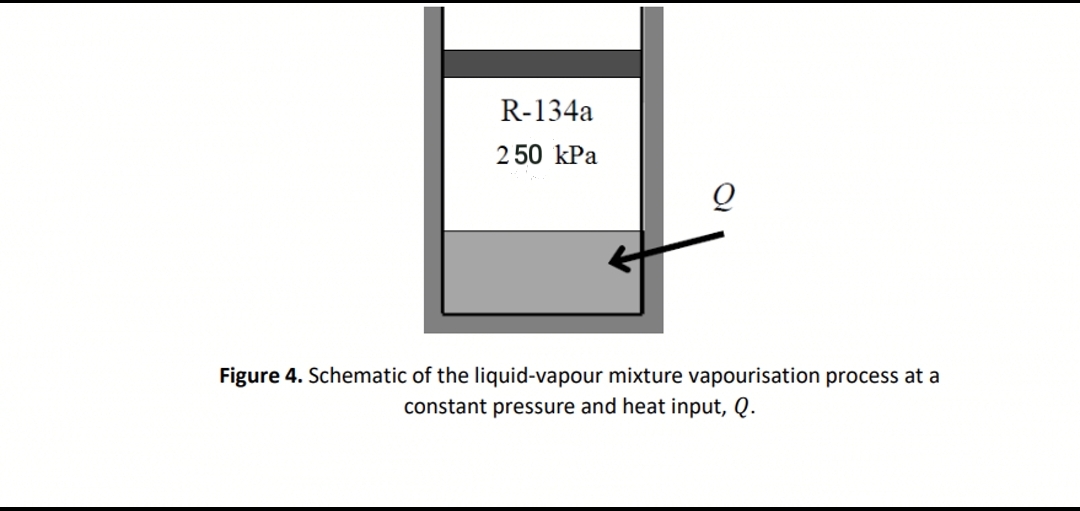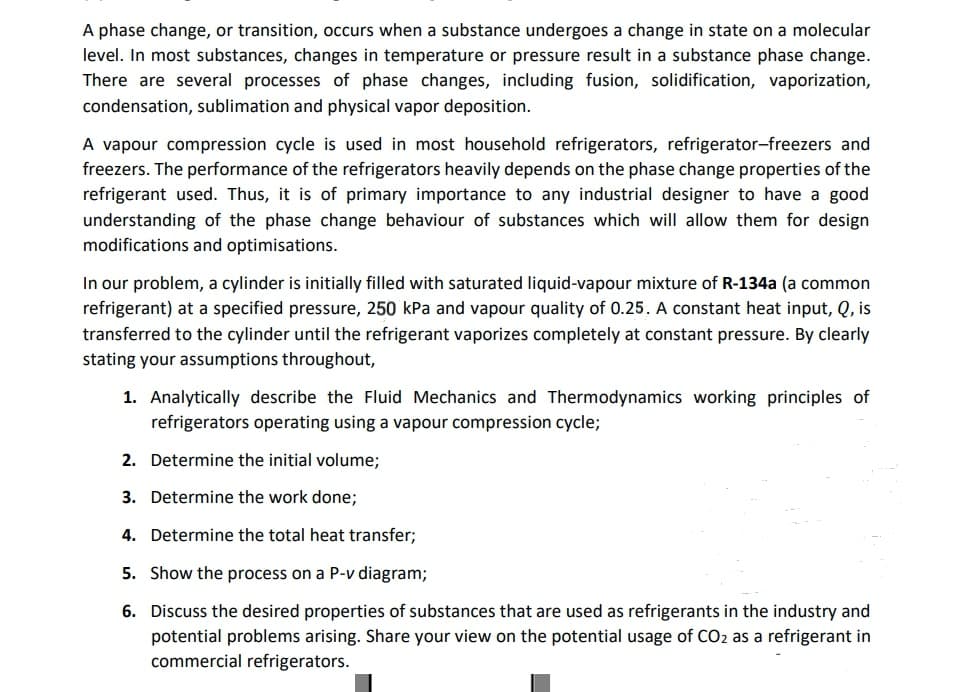A phase change, or transition, occurs when a substance undergoes a change in state on a molecular level. In most substances, changes in temperature or pressure result in a substance phase change. There are several processes of phase changes, including fusion, solidification, vaporization, condensation, sublimation and physical vapor deposition. A vapour compression cycle is used in most household refrigerators, refrigerator-freezers and freezers. The performance of the refrigerators heavily depends on the phase change properties of the refrigerant used. Thus, it is of primary importance to any industrial designer to have a good understanding of the phase change behaviour of substances which will allow them for design modifications and optimisations. In our problem, a cylinder is initially filled with saturated liquid-vapour mixture of R-134a (a common refrigerant) at a specified pressure, 250 kPa and vapour quality of 0.25. A constant heat input, Q, is transferred to the cylinder until the refrigerant vaporizes completely at constant pressure. By clearly stating your assumptions throughout, 1. Analytically describe the Fluid Mechanics and Thermodynamics working principles of refrigerators operating using a vapour compression cycle; 2. Determine the initial volume; 3. Determine the work done; 4. Determine the total heat transfer; 5. Show the process on a P-v diagram; 6. Discuss the desired properties of substances that are used as refrigerants in the industry and potential problems arising. Share your view on the potential usage of CO₂ as a refrigerant in commercial refrigerators.
A phase change, or transition, occurs when a substance undergoes a change in state on a molecular level. In most substances, changes in temperature or pressure result in a substance phase change. There are several processes of phase changes, including fusion, solidification, vaporization, condensation, sublimation and physical vapor deposition. A vapour compression cycle is used in most household refrigerators, refrigerator-freezers and freezers. The performance of the refrigerators heavily depends on the phase change properties of the refrigerant used. Thus, it is of primary importance to any industrial designer to have a good understanding of the phase change behaviour of substances which will allow them for design modifications and optimisations. In our problem, a cylinder is initially filled with saturated liquid-vapour mixture of R-134a (a common refrigerant) at a specified pressure, 250 kPa and vapour quality of 0.25. A constant heat input, Q, is transferred to the cylinder until the refrigerant vaporizes completely at constant pressure. By clearly stating your assumptions throughout, 1. Analytically describe the Fluid Mechanics and Thermodynamics working principles of refrigerators operating using a vapour compression cycle; 2. Determine the initial volume; 3. Determine the work done; 4. Determine the total heat transfer; 5. Show the process on a P-v diagram; 6. Discuss the desired properties of substances that are used as refrigerants in the industry and potential problems arising. Share your view on the potential usage of CO₂ as a refrigerant in commercial refrigerators.
Elements Of Electromagnetics
7th Edition
ISBN:9780190698614
Author:Sadiku, Matthew N. O.
Publisher:Sadiku, Matthew N. O.
ChapterMA: Math Assessment
Section: Chapter Questions
Problem 1.1MA
Related questions
Question

Transcribed Image Text:R-134a
250 kPa
Q
Figure 4. Schematic of the liquid-vapour mixture vapourisation process at a
constant pressure and heat input, Q.

Transcribed Image Text:A phase change, or transition, occurs when a substance undergoes a change in state on a molecular
level. In most substances, changes in temperature or pressure result in a substance phase change.
There are several processes of phase changes, including fusion, solidification, vaporization,
condensation, sublimation and physical vapor deposition.
A vapour compression cycle is used in most household refrigerators, refrigerator-freezers and
freezers. The performance of the refrigerators heavily depends on the phase change properties of the
refrigerant used. Thus, it is of primary importance to any industrial designer to have a good
understanding of the phase change behaviour of substances which will allow them for design
modifications and optimisations.
In our problem, a cylinder is initially filled with saturated liquid-vapour mixture of R-134a (a common
refrigerant) at a specified pressure, 250 kPa and vapour quality of 0.25. A constant heat input, Q, is
transferred to the cylinder until the refrigerant vaporizes completely at constant pressure. By clearly
stating your assumptions throughout,
1. Analytically describe the Fluid Mechanics and Thermodynamics working principles of
refrigerators operating using a vapour compression cycle;
2. Determine the initial volume;
3. Determine the work done;
4. Determine the total heat transfer;
5. Show the process on a P-v diagram;
6. Discuss the desired properties of substances that are used as refrigerants in the industry and
potential problems arising. Share your view on the potential usage of CO2 as a refrigerant in
commercial refrigerators.
Expert Solution
This question has been solved!
Explore an expertly crafted, step-by-step solution for a thorough understanding of key concepts.
Step by step
Solved in 4 steps with 4 images

Knowledge Booster
Learn more about
Need a deep-dive on the concept behind this application? Look no further. Learn more about this topic, mechanical-engineering and related others by exploring similar questions and additional content below.Recommended textbooks for you

Elements Of Electromagnetics
Mechanical Engineering
ISBN:
9780190698614
Author:
Sadiku, Matthew N. O.
Publisher:
Oxford University Press

Mechanics of Materials (10th Edition)
Mechanical Engineering
ISBN:
9780134319650
Author:
Russell C. Hibbeler
Publisher:
PEARSON

Thermodynamics: An Engineering Approach
Mechanical Engineering
ISBN:
9781259822674
Author:
Yunus A. Cengel Dr., Michael A. Boles
Publisher:
McGraw-Hill Education

Elements Of Electromagnetics
Mechanical Engineering
ISBN:
9780190698614
Author:
Sadiku, Matthew N. O.
Publisher:
Oxford University Press

Mechanics of Materials (10th Edition)
Mechanical Engineering
ISBN:
9780134319650
Author:
Russell C. Hibbeler
Publisher:
PEARSON

Thermodynamics: An Engineering Approach
Mechanical Engineering
ISBN:
9781259822674
Author:
Yunus A. Cengel Dr., Michael A. Boles
Publisher:
McGraw-Hill Education

Control Systems Engineering
Mechanical Engineering
ISBN:
9781118170519
Author:
Norman S. Nise
Publisher:
WILEY

Mechanics of Materials (MindTap Course List)
Mechanical Engineering
ISBN:
9781337093347
Author:
Barry J. Goodno, James M. Gere
Publisher:
Cengage Learning

Engineering Mechanics: Statics
Mechanical Engineering
ISBN:
9781118807330
Author:
James L. Meriam, L. G. Kraige, J. N. Bolton
Publisher:
WILEY